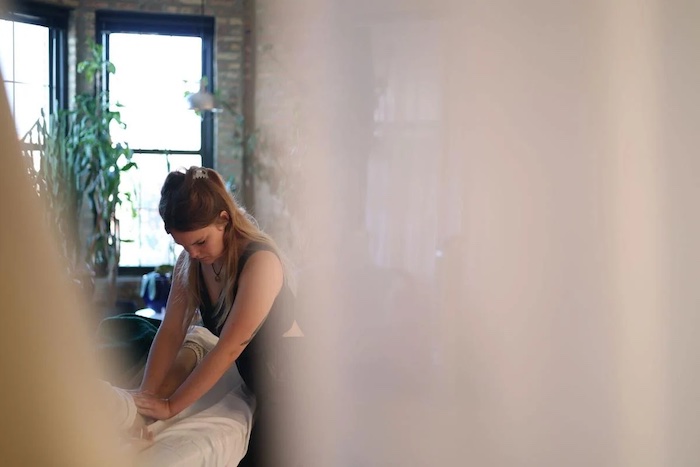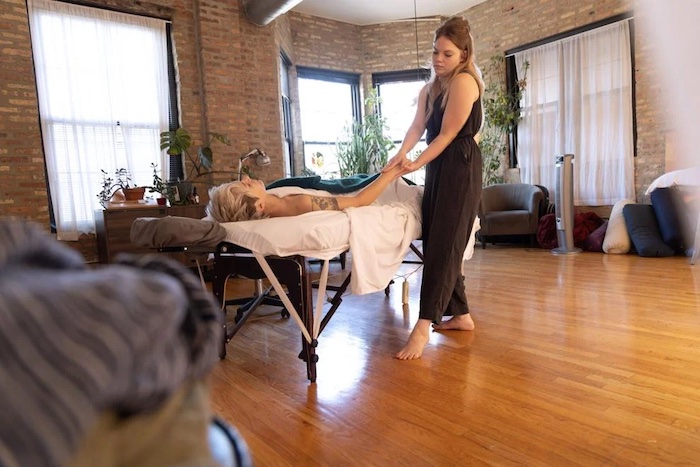— ‘I realized death can be positive.’

Mary Phelps, a grief massage therapist and Shiatsu bodyworker, gives a client a massage on Aug. 28, 2023, in Chicago. Phelps’ work focuses on getting the nervous system to calm down. Phelps is a member of the Chicago Death Doula Collective.
By
At age 19, Mary Phelps stood at her grandmother’s bedside. In mere minutes, she would watch the woman with whom she had shared a home and a life take her final breaths.
She held her grandmother’s legs, lightly massaging them as the seconds ticked by. “I just remembered her becoming so young in the face and relaxed,” Phelps said. “That’s when it came to me. Death can be calm and peaceful.”
Phelps’ perspective toward death and dying would forever be changed.
“It was just a really beautiful moment,” Phelps said of her grandmother’s passing. “So to see that, I realized death can be positive.”
Now, six years after that transformative moment, Phelps is one of Chicago’s youngest death doulas at age 25.
The role of a death doula is to educate clients on what to expect at the end of life. The little-known field is centered around easing an individual’s dying process, such as by informing the person of their burial options, serving as a point-of-contact between the person and their loved ones, and assisting in caregiving. And Chicago’s young and diverse end-of-life care workers are striving to provide comfort and representation during an inevitable period of life.
Young doulas say they aim to change the perception that death is laden with gloom.
Phelps, for example, opened the door to her North Center office sporting a messy bun atop her head and a welcoming smile. She pressed her hands together in a namaste symbol and offered a small bow.
With an elephant tattoo on her arm and beads in her hand (a gift for completing her doula training), she sat down, folded her legs in a rolling office chair and began to share her story. When the beads broke between her fingers as she spoke, she smiled and said, “must be the energy clearing.”
Phelps describes herself as “death positive.” While the expression may raise eyebrows, she uses it as a way of calling attention to the impact of her work.
“I think some people hear the word ‘death’ and they’re like, ‘What witchcraft is going on here?’ But it’s not like that,” she said. “It’s just helping us to give better care to those that are dying, because they get neglected a lot.”
Phelps channels better care through touch. She offers massages to hospice patients, fulfilling a need that she feels is underappreciated in the elderly community.
“A lot of times, they may not even be getting hugs or even gentle pats on the back,” she said. “So the way I see it … touch can help them feel more comforted and safe. It brings a calming presence. Yes, this is a scary time, but this can be a safe space.”
The fear surrounding death is something that Phelps has encountered throughout her career. However, she and her partners at the Chicago Death Doula Collective work to help communities unlearn that fear.
Phelps may be one of the youngest death doulas providing care in Chicago communities, but she is not the only one.
Sam Kopas, 34, is new to the death doula scene. While on a thrifting excursion, she spotted a flyer advertising support for elder care, with one of the options listed as “death doula.”
“I thought that’s the craziest thing I’ve ever heard,” Kopas said.
The flyer made her think about her travels through Europe with her husband. She recalled seeing the Prague Astronomical Clock that tolls every hour, reminding her that regardless of your age, death comes for us all.
“I thought that was really metal,” she said with a chuckle. With those memories coming to mind, she said she suddenly became acutely aware of the infrequency of open conversations surrounding death in America.
With her interest peaked, Kopas began to research Chicagoland death doulas to learn more about the practice. Soon, she found herself under the tutelage of Catherine Durkin Robinson, the owner of Anitya Doula Services and a death doula and educator.
Kopas became one of Robinson’s youngest students.
“I love seeing younger people. We need as many people as possible to get into this because so many different kinds of folks feel comfortable with so many different kinds of folks,” Robinson said. “I want to see more people who are trans, who are part of the LGBTQ community, getting trained to do this work.
“I think she brings a really bright perspective to the work,” Robinson said of Kopas. “Because sometimes when we’re dying, we want to be around people that have familiar language, that use similar words, sometimes that look the same and are in tune with what we’re going through.”
Robinson said that although younger workers are needed in the field, youth does not come without its challenges. She said some patients prefer an older practitioner. “Being in end-of-life work as an older woman, I’m thrilled with this process of getting wiser. That’s actually needed in this work,” Robinson said. “It’s comforting; we know a thing or two and we’ve been around the block.”
Kopas echoed these concerns, saying, “I definitely think there’s some challenge with clients because when there’s an age gap that’s so significant, where someone’s in their 70s or 80s talking to someone who’s a good deal younger than them, there’s probably even more of that intensity of, ‘What would you know that I don’t at this point?’”
Kopas navigates that resistance by acknowledging the challenge as it arises. She said that holding the client in unconditional positive regard and addressing their discomfort directly is the key.
“Just saying, ‘I hear you, this is rough,’” Kopas said. “I’m certainly not here to fix the disease or cure it, but to give you the most comfortable space in the end.”
When envisioning end-of-life care, Kopas said, a “standard kind of patient” comes to mind, someone elderly and bound to a hospital bed. But not everyone seeking end-of-life care is elderly. For young patients, doulas can adjust the care and comfort priorities.
Community health care worker Kandis Draw was forced to grapple with such adjustments as she cared for her sister battling liver failure at age 22. While burdened with grief, she discovered the distinct differences of navigating the dying process with someone in their 20s.
“When you deal with people who are in their 60s and up, some of them have the attitude, ‘Well, I’ve lived my life. I don’t have any regrets,’” she said.
She recalled one senior saying, “When you get old, stuff happens to you. There’s no way around that.”
This peaceful acceptance can starkly differ for those who are dying at a young age. According to Draw, 41, young patients can be burdened with a different sentiment. “‘This is not fair. I deserve another chance. I wasn’t parented right. I wasn’t cared for right. I didn’t have the resources. People just threw me out there,’” Draw said, recounting some of the comments she’s heard over the years.
Despite their grief, Draw said she was able to connect with these patients. “I think that you can communicate better when it’s someone that’s close to your age. You can have more of an open conversation,” she said.
Like Draw, Maureen Burns, who is 38 and a fellow collaborator with the Illinois-based HAP Foundation for hospice and palliative care, considers her work to be heavily influenced by her personal experience with grief and loss.

Mary Phelps gives a massage on Aug. 28, 2023, in Chicago.
Hospice is comfort care without curative intent; the patient no longer has curative options or has chosen not to pursue treatment. Palliative care is comfort care for people with a serious illness with or without curative intent.
Burns reflected on the death of her father in 2021. Despite working in health care, it took her a “surprisingly long time” to realize that her father was a candidate for hospice care. He struggled with chronic obstructive pulmonary disease, or COPD. While his decline in health made daily living and traveling to doctors’ appointments challenging, she did not consider that those challenges could be addressed by hospice care. “I think that informs my work now,” Draw said. “If it was that hard for me, imagine someone who hasn’t heard the word hospice. Imagine what they could be missing out on.”
For Kopas, becoming a doula was a way to bypass structures that imagine a standard patient. “I know lots of families that don’t think that hospice would be a good fit for them because they don’t fit the standard kind of patient or family that would go through it,” she said.
Kopas focuses on ensuring that everyone has the information they need. “Did you know that green burial is an option? Did you know that palliative care can start early? Did you know that you can opt into hospice and then opt out if you want?” she asked. “All of this is just stuff that I felt like, if I could be a messenger for that kind of information to people who didn’t know it, then that would be a significant improvement right there.”
For many of Chicago’s end-of-life-care workers, having conversations about a patient’s legacy and final moments have affected how they plan to move forward in their own lives.
Kopas found death doula work to be her method of leaving a lasting legacy in the world. She recently concluded that “parenting might not be for me.” This decision led her to ponder “what could I still do and bring to the world that would be valuable and helpful, and offer a perspective and nuance and ease someone’s time here.”
The answer was to be there for people when they are at their most vulnerable.
Phelps’ open and positive approach toward death isn’t limited to her work. She has begun planning for her own death and encourages other young people to consider what a good death would look like for them.
For her, a good death would take place in her home, after which she would have a water cremation and have her ashes turned into a diamond. Although many young people don’t like to discuss death, the 25-year-old said firmly that, “Dying does not have to be a scary process.”
The work of the city’s death doulas also reminds the public that advanced care planning can be pursued at any age.
“Death work isn’t an exclusively older generation (issue),” Kopas said. “It can be a regular conversation. Having these chats before anything tragic, terminal or diagnosis-related happens is a large benefit that a lot of people don’t think about.”
Chicago’s young end-of-life specialists provide varied forms of care. Draw hosts conversations with her Englewood neighbors who are navigating existential dread. Phelps massages the shoulders of an Uptown resident who has spent years bearing the burden of grief. Burns sits with Far North Side neighbors planning for a nearly unspeakable reality where they leave their children behind. Kopas spends hours studying the logistics of hospice care options so her client has the information needed for a death with dignity.
Regardless of the day-to-day appearance of their work, one message stays consistent: All of Chicago’s communities need end-of-life support.
“We need younger workers, older workers, Black workers, Hispanic — we need everybody because everybody is gonna need this type of care. It’s not just one group that dies or gets sick,” Burns said. “Everybody needs it.”
Complete Article ↪HERE↩!
